Are books dead?
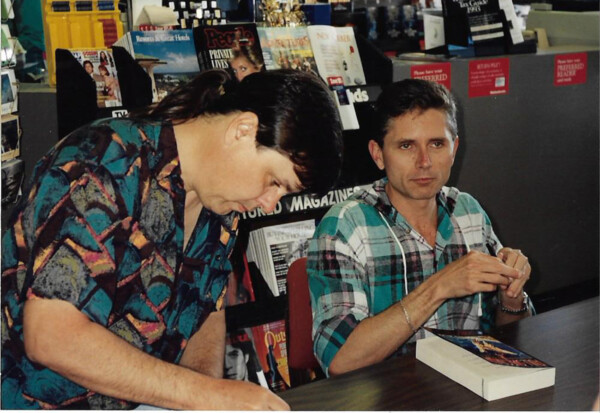
Yours truly (right) signs copies of "Full Spectrum 4" with Ray Aldridge (left) at a signing event at the Waldenbooks at Santa Rosa Mall in Mary Esther, Fla., in 1993. I don't know who took this photo.
I have been writing since the eighth grade. I began selling professionally in the mid–’90s and as recently as last year made the finals of the British Fantasy Award.
Around 2000 I began to wonder if there was any point in continuing. My sense was books were headed in the same direction as newspapers and magazines – marginalized by the web and video games and cell phones … and I guess the general illiteracy that seems to be overtaking the world.
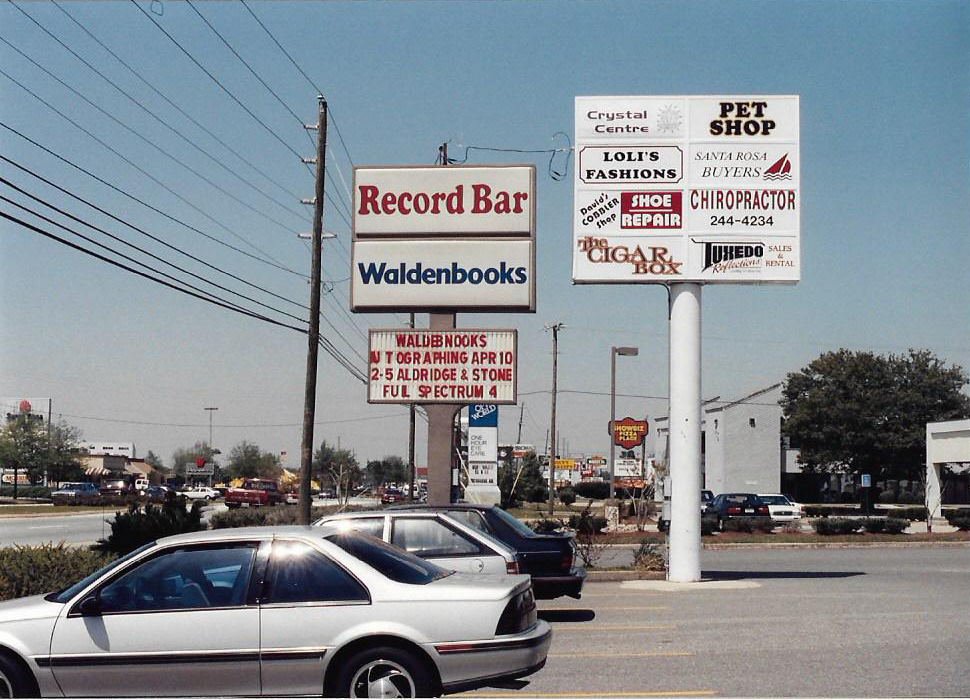
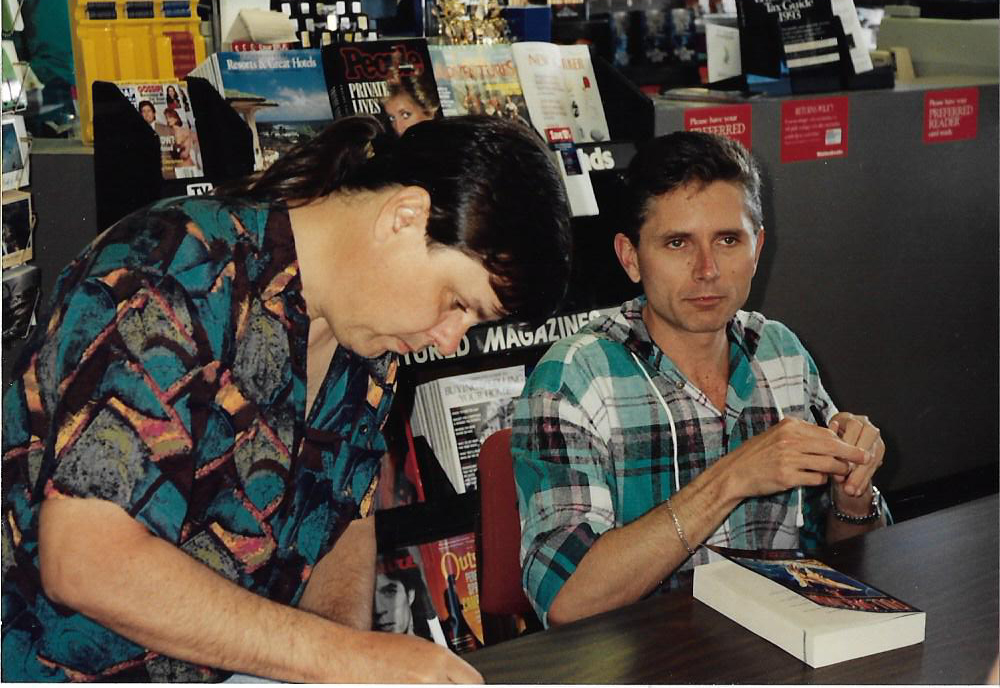
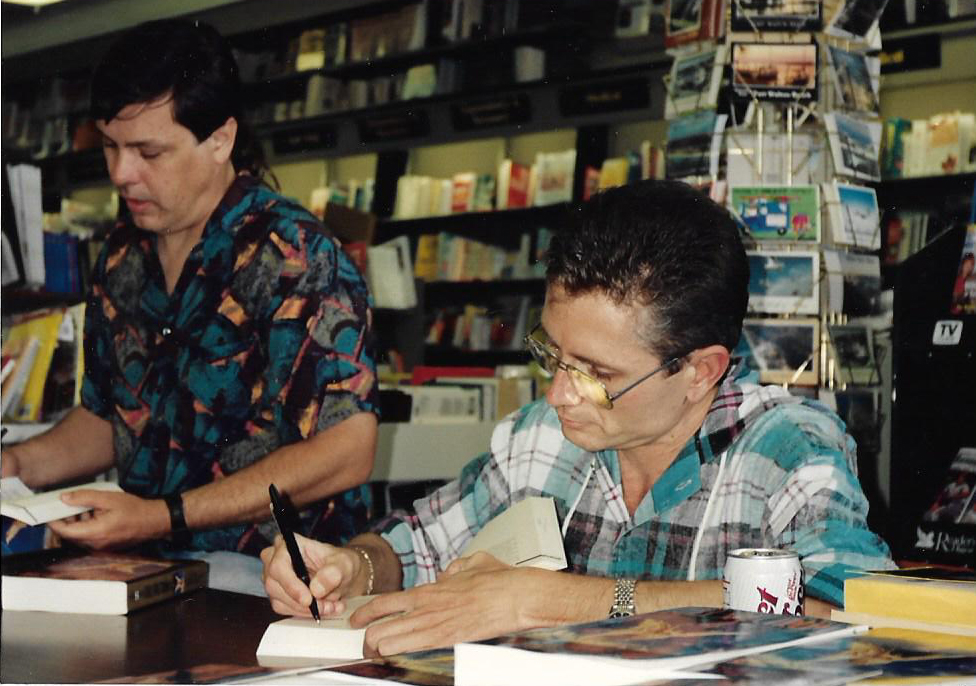
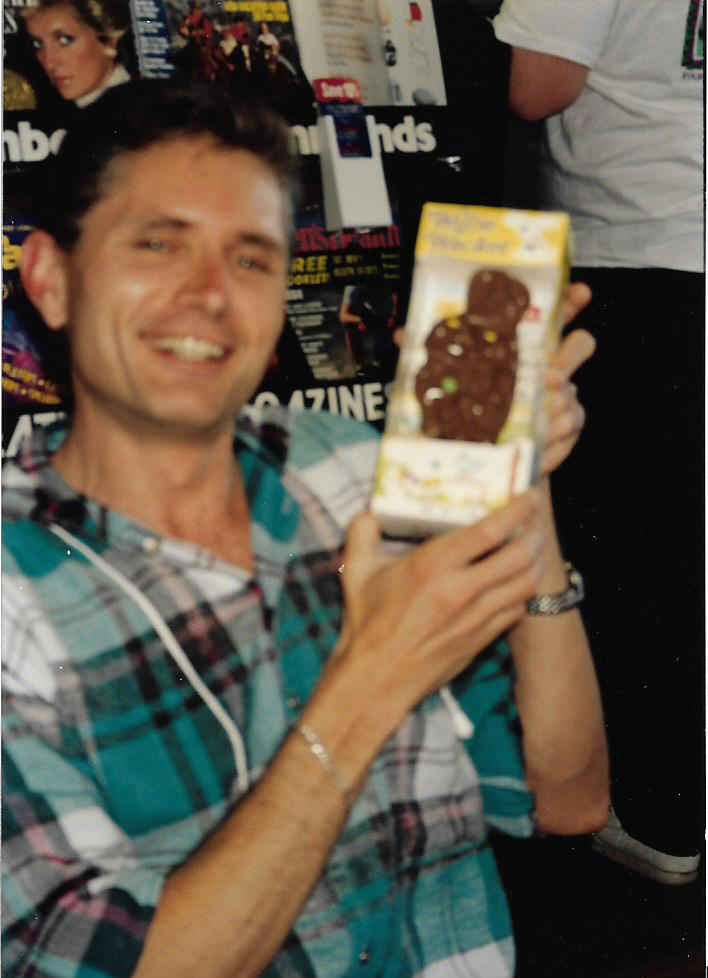
I’ve dedicated a significant portion of my life to learning the use of words as an art form and lately I miss doing that. I suppose it has something to do with work, which has gone from providing an outlet for my creativity to confronting me with a relentless assembly line of button–pushing and software configuring.
But again, is there any point? I pose this question to the professional writers on my friends list who are still writing and, presumably, selling. Are there markets for novels? Do writers get paid for their work? Is the book an end or merely a means to an end, like a movie deal?
I would like to start writing again but I don’t want to do that if it means giving away my work or worse, having it lie fallow in my computer.
I know. That violates every tenet of the artist who is compelled to create regardless of markets and advances and licensing rights issues. Still, when I hear that Bantam Books has been shut down and mid–list writers are being muscled out of the business I wonder if my time wouldn’t be better spent at the local vocational–technical school learning a trade.
So … if you have any thoughts on the subject and would like to comment, I’d appreciate the input.
About the author:
Del Stone Jr. is a professional fiction writer. He is known primarily for his work in the contemporary dark fiction field, but has also published science fiction and contemporary fantasy. Stone’s stories, poetry and scripts have appeared in publications such as Amazing Stories, Eldritch Tales, and Bantam-Spectra’s Full Spectrum. His short fiction has been published in The Year’s Best Horror Stories XXII; Alfred Hitchcock’s Mystery Magazine; the Pocket Books anthology More Phobias; the Barnes & Noble anthologies 100 Wicked Little Witch Stories, Horrors! 365 Scary Stories, and 100 Astounding Little Alien Stories; the HWA anthology Psychos; and other short fiction venues, like Blood Muse, Live Without a Net, Zombiesque and Sex Macabre. Stone’s comic book debut was in the Clive Barker series of books, Hellraiser, published by Marvel/Epic and reprinted in The Best of Hellraiser anthology. He has also published stories in Penthouse Comix, and worked with artist Dave Dorman on many projects, including the illustrated novella “Roadkill,” a short story for the Andrew Vachss anthology Underground from Dark Horse, an ashcan titled “December” for Hero Illustrated, and several of Dorman’s Wasted Lands novellas and comics, such as Rail from Image and “The Uninvited.” Stone’s novel, Dead Heat, won the 1996 International Horror Guild’s award for best first novel and was a runner-up for the Bram Stoker Award. Stone has also been a finalist for the IHG award for short fiction, the British Fantasy Award for best novella, and a semifinalist for the Nebula and Writers of the Future awards. His stories have appeared in anthologies that have won the Bram Stoker Award and the World Fantasy Award. Two of his works were optioned for film, the novella “Black Tide” and short story “Crisis Line.”
Stone recently retired after a 41-year career in journalism. He won numerous awards for his work, and in 1986 was named Florida’s best columnist in his circulation division by the Florida Society of Newspaper Editors. In 2001 he received an honorable mention from the National Lesbian and Gay Journalists Association for his essay “When Freedom of Speech Ends” and in 2003 he was voted Best of the Best in the category of columnists by Emerald Coast Magazine. He participated in book signings and awareness campaigns, and was a guest on local television and radio programs.
As an addendum, Stone is single, kills tomatoes and morning glories with ruthless efficiency, once tied the stem of a cocktail cherry in a knot with his tongue, and carries a permanent scar on his chest after having been shot with a paintball gun. He’s in his 60s as of this writing but doesn’t look a day over 94.
Contact Del at [email protected]. He is also on Facebook, twitter, Pinterest, tumblr, TikTok, and Instagram. Visit his website at delstonejr.com .
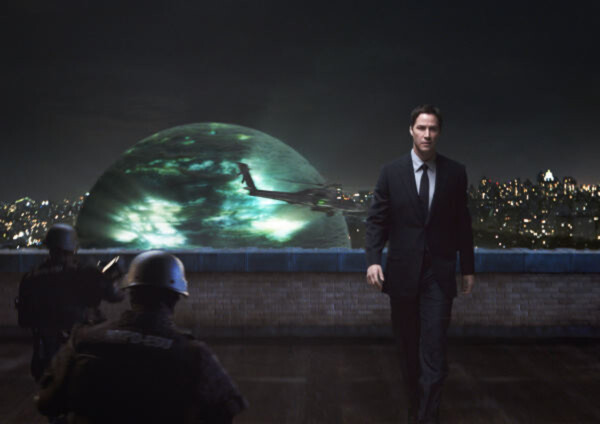
Klaatus (Keanu Reeves) arrival on Earth via a giant sphere, triggers a global upheaval.
Image courtesy of 20th Century Fox.
—
“The Day the Earth Stood Still,” starring Keanu Reeves, Jennifer Connelly, Kathy Bates, Jaden Smith, and John Cleese. Directed by Scott Derrickson, 103 minutes, rated PG-13.
Mladen’s take
Add the recently released re-make of “The Day the Earth Stood Still” to the ever-growing list of hokey films about redemption.
In fact, if you’re tired of watching Rudolph the red-nosed reindeer and his dwarf friend discover that they’re wonderful beings no matter what anyone else believes, consider “The Day the Earth Stood Still” as alternative holiday viewing fare. Here, the whole of humanity is redeemed.
There are no subtleties in this sci-fi movie.
Klaatu, the alien portrayed by Keanu Reeves, arrives aboard a cloudy, sparkling sphere. He’s an interstellar diplomat without portfolio sent by a god-like cabal of deep-space civilizations.
Klaatu’s mission is to evaluate Earth’s health. The prognosis ain’t good.
It isn’t too long before he tells astrobiologist and unwitting ally Helen Benson, played by Jennifer Connelly, that extra-galactic help would be needed to save the planet.
Benson assumes that means helping humanity but eventually figures out she’s mistaken. Klaatu had concluded that the only way to save Earth is by eradicating mankind.
The universal diplomat, protected by GORT, a very impressive gigantic automaton comprised of nano-sized wasps behaving as a single being, initiates Operation Roach Motel after explaining to Benson that, in essence, humanity is a cosmic error.
Meanwhile, what does the U.S. Defense Department do when it encounters hyper-intelligent, unbelievably technologically sophisticated entities from distant worlds? It tries to kill them, of course.
Throughout the movie, Klaatu or GORT turn military target acquisition devices, laser illuminators and high-performance aircraft against the troops using them. The aliens – masters of the electro-magnetic spectrum, severe traumatic injury repair, pure reason, and unemotive faces – gain control of the weapons systems by wireless hacking.
It takes Benson’s unceasing effort to protect her belligerent young stepson and a brief exchange of mathematical equations and a little conversation with a Nobel Prize-winning scientist for Klaatu to start recognizing that humanity ain’t all bad.
It seems – and this has never, ever, been expressed in other movies, books, poems, pamphlets, hieroglyphics or pre-Sumarian script – that humanity can become its best only after demonstrating its worst. The Nobel laureate argues that mankind has some kind of intrinsic sense that will let it know when there has been enough bloodletting and destruction of the environment, as well as the moral fortitude to correct those mistakes when the time comes.
Klaatu starts seeing the microscopic good among the overwhelming evil around him and reverses his decision to obliterate all traces of humanity. The mechanism for scraping clean the Earth’s surface is the neatest visual part of the movie. GORT dissolves into a swarm of flying nano-bots that consumes everything in its path, organic or inorganic.
The swarm is one of a few transparently biblical references in “The Day the Earth Stood Still.” Hell, at one point Klaatu even walks on water. Hallelujah.
“The Day the Earth Stood Still” is an OK movie, probably worth the price of a matinee ticket. But, I’m worried about Reeves. Come on, man, next time give me something as spectacular and revolutionary as “The Matrix.”
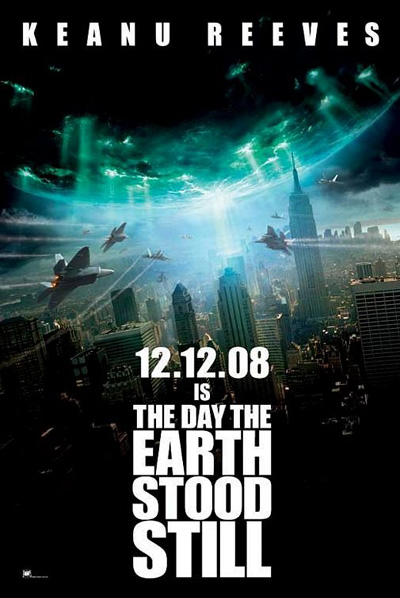
Del’s take
It isn’t the Earth that’s standing still – it’s Hollywood.
Talk about a movie that didn’t need remaking. “The Day the Earth Stood Still” circa 1951 is a Robert Wise classic that to this day presents a quietly dignified message about the follies of war.
“The Day the Earth Stood Still” circa 2008 is a diabetic coma-inducing fried Snickers bar of a mess, covered with sugar-dot cliches and gluey nuggets of contrived melodrama – all of it wrapped in a cloying caramel blanket of unconvincing CGI.
I’m still trying to figure out which cliché most nauseates me – the save-the-environment cliché, the racial-harmony cliché, the empowered woman cliché, the all-government-employees-are-evil cliché, the stupid-military cliché … see what I mean? One more cliche and you’d have a C-bomb big enough to do the aliens’ work for them.
Most of the characters in “The Day the Earth Stood Still” are cardboard cut-outs with Keanu Reeves winning the Oscar for Best Performance by a Stoned-Out Quualude Refugee. The lone exception is Will Smith’s kid, Jaden, who plays the rebellious and disrespectful stepson of Jennifer Connelly’s Helen Benson character (has there ever been a stepchild who liked his new mom or dad?).
Let’s not talk about logic flaws … well heck, let’s do.
Here’s the deal: The aliens have come to Earth because there are few habitable planets in the galaxy and humanity is ruining this one. To fix everything the aliens plan to unleash a biblical horde of tiny robots that will dismantle mankind molecule by molecule, restoring the earth to pristine form … presumably to serve as home base for a future alien megalopolis.
Stop and think about it – if E.T. has that kind of technology, why not unleash it on an uninhabitable world, making it habitable? Science calls the process “terraforming,” a piece of cake for Klaatu and pals.
But then there’d be no movie – albeit a stupid movie, and be $8 to the richer. And I could use that $8 to make the world a better place so we’d never again be afflicted with Keanu Reeves.
Or I could just buy beer to wash away the taste of this nasty movie.
Mladen Rudman is a former journalist and technical writer. Del Stone Jr. is a journalist and author.
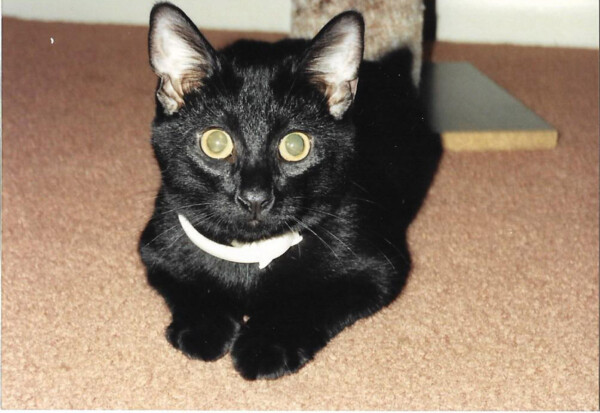
Photo courtesy of Del Stone Jr.
This morning I took Pavlov to the vet and she had The Talk with me.
The Talk amounted to this: If at any moment after today I look into his eyes and decide he’s had enough she would support my decision.
So. My old friend’s life is in my hands.
I am giving him double the insulin and double the fluids I was before. He has three kinds of food he can choose from. He gets a massage/brushing every day, a laxative to keep him from becoming constipated, and antibiotics for a persistent respiratory infection. Apart from that there’s nothing I can do.
He spends his day crouched on the Polo beach towel by the door to my office. He still eats, drinks and poops but that’s about it. Sometimes he will visit me on the couch but he always retires to the floor behind the stereo.
From a human perspective that’s not much of a life, but for a cat it may be exactly what he wants right now.
I don’t think he’s suffering. He doesn’t look like he’s in pain. But I can see he’s tired, maybe too tired. I don’t know.
Once before I said I’d give him a week. Sure enough he bounced back. But the news today suggests he may have used up all the reservoirs of strength he’s been running on.
We’ll see how he’s doing at the end of the week. I’ve got to give the insulin a chance to work.
If it doesn’t, however, then I guess I will do what a friend would do.
About the author:
Del Stone Jr. is a professional fiction writer. He is known primarily for his work in the contemporary dark fiction field, but has also published science fiction and contemporary fantasy. Stone’s stories, poetry and scripts have appeared in publications such as Amazing Stories, Eldritch Tales, and Bantam-Spectra’s Full Spectrum. His short fiction has been published in The Year’s Best Horror Stories XXII; Alfred Hitchcock’s Mystery Magazine; the Pocket Books anthology More Phobias; the Barnes & Noble anthologies 100 Wicked Little Witch Stories, Horrors! 365 Scary Stories, and 100 Astounding Little Alien Stories; the HWA anthology Psychos; and other short fiction venues, like Blood Muse, Live Without a Net, Zombiesque and Sex Macabre. Stone’s comic book debut was in the Clive Barker series of books, Hellraiser, published by Marvel/Epic and reprinted in The Best of Hellraiser anthology. He has also published stories in Penthouse Comix, and worked with artist Dave Dorman on many projects, including the illustrated novella “Roadkill,” a short story for the Andrew Vachss anthology Underground from Dark Horse, an ashcan titled “December” for Hero Illustrated, and several of Dorman’s Wasted Lands novellas and comics, such as Rail from Image and “The Uninvited.” Stone’s novel, Dead Heat, won the 1996 International Horror Guild’s award for best first novel and was a runner-up for the Bram Stoker Award. Stone has also been a finalist for the IHG award for short fiction, the British Fantasy Award for best novella, and a semifinalist for the Nebula and Writers of the Future awards. His stories have appeared in anthologies that have won the Bram Stoker Award and the World Fantasy Award. Two of his works were optioned for film, the novella “Black Tide” and short story “Crisis Line.”
Stone recently retired after a 41-year career in journalism. He won numerous awards for his work, and in 1986 was named Florida’s best columnist in his circulation division by the Florida Society of Newspaper Editors. In 2001 he received an honorable mention from the National Lesbian and Gay Journalists Association for his essay “When Freedom of Speech Ends” and in 2003 he was voted Best of the Best in the category of columnists by Emerald Coast Magazine. He participated in book signings and awareness campaigns, and was a guest on local television and radio programs.
As an addendum, Stone is single, kills tomatoes and morning glories with ruthless efficiency, once tied the stem of a cocktail cherry in a knot with his tongue, and carries a permanent scar on his chest after having been shot with a paintball gun. He’s in his 60s as of this writing but doesn’t look a day over 94.
Contact Del at [email protected]. He is also on Facebook, twitter, Pinterest, tumblr, TikTok, Ello and Instagram. Visit his website at delstonejr.com .
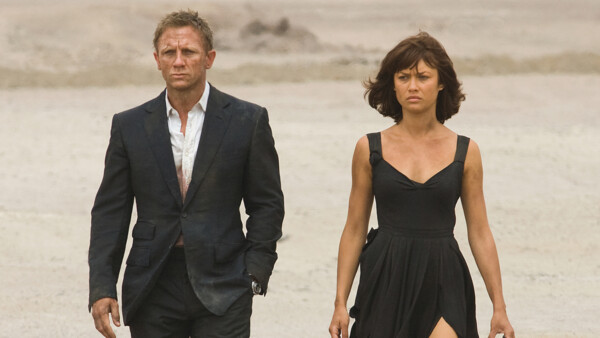
James Bond (DANIEL CRAIG) and Camille (OLGA KURYLENKO) walk through the Bolivian desert. Location: Chile
Image courtesy of MGM.
—
“Quantum of Solace” Starring Daniel Craig, Olga Kurylenko, Mathieu Amalric and Judi Dench. Directed by Marc Forster. 106 minutes. Rated PG-13.
Del’s take
Don’t ask a James Bond purist what he thinks of “Quantum of Solace.” He’ll likely curl his lip, let out an exasperated huff and mutter something to the effect, “They’ve ruined 007!”
And well they might. Like many fictional characters who have made the transition from 20th century escapism to 21st century realism, Bond has been transformed. “Quantum of Solace” continues that evolution.
(Warning: Spoilers follow.)
The plot is classic 007. A super-secret organization known only as Quantum angles to depose the current Bolivian government and replace it with a strongman willing to sign over that country’s most precious resource – water. Give the screenwriters credit: They anticipate the ferocious competition predicted by climatologists to result from global warming and its diminishment of potable water supplies.
Despite orders to the contrary from the redoubtable M (Judi Dench), Bond (Daniel Craig) travels to South America to discover exactly why it is ersatz environmentalist Dominic Greene (Mathieu Amalric) has taken such an interest in an apparently barren desert. Vengeance is a subplot. Bond seeks payback for the death of Vesper Lynd while Bond’s female counterpart, a Bolivian secret service agent, Camille (Olga Kurylenko) aims to kill the appointed strongman who murdered her parents.
The action is hyperkinetic and at times almost unwatchable as exquisitely choreographed fight scenes unfold at a blistering pace, leaving Bond a dirty, bloody shambles who nevertheless prevails over the bad guy de jour.
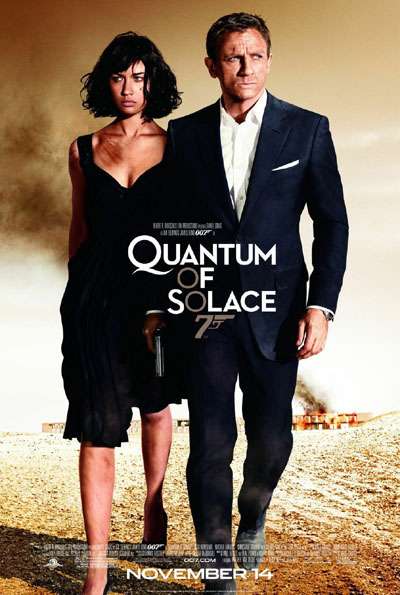
Almost lost amid Craig’s intensity is the humor – not the campy double entendres of Roger Moore’s Bond or the sly sophistication of a Sean Connery, but actual comedy that launches unexpectedly from the darkness. Upon arriving in Bolivia, Bond is escorted by a sexy British agent to a seedy hotel where they will pose as exchange teachers. Unhappy with the accommodations, Bond takes them to the ritziest hotel in town where he explains to the desk clerk, “We are exchange teachers – and we just won the lottery.”
But much goes missing in “Quantum of Solace,” and this is where purists will hold their noses. Lost is the suave, indefatigable James Bond who emerges from a wet suit wearing a tuxedo, his hair unmussed. Gone are the insane luxuries of the super-rich, the creatively dysfunctional devices of murder (death by laser emasculation) , and the over-the-top malevolence of the ultra-evil.
Worse, we see Bond bleed, and that is not part of the Sean Connery canon of an unreachable and untouchable super man. It is as if Bond has also been tainted by the economic meltdown and would trade his beloved martinis for a can of Miller Lite.
This new Bond is more Serpico than, well, James Bond, and while that may satisfy critics one must wonder if the paying public will believe its escapist dollars have been well spent. So far box office receipts have been excellent so it’s hard to argue with numbers.
Ultimately you must ask yourself: Why do people go to movies? If it is to see a reasonable facsimile of yourself then the new, evolved James Bond may work.
But if it is to see a spectacle that rises above the gritty ordinariness of life, expect a regime change in the James Bond pantheon of superheroes.
Del Stone Jr. is a former journalist and author.

In this photo, Pavlov sits amid the ruins of tractor-feed perforation strips from my old Okidata dot-matrix computer printer. He loved playing with those strands of paper and usually created a huge mess. Photo by Del Stone Jr.
—
OK, so this blog is about a cat. Pavlov. MY cat. He’s sick and it scares me. I don’t want him to die.
Pavlov was here in 1992 when I was trying to recover from a catastrophic relationship. He didn’t know it but he helped me through that.
He was here on Oct. 4, 1995, when Category 4 Hurricane Opal roared across the Florida Panhandle. He didn’t know what was happening and his calm demeanor helped me cope with the terrifying destruction I watched fly past my window.
He was here in October 1998 when my father was dying and I finally broke down and cried for the first time in 25 years. He crawled into my lap and pawed at my chest as I sobbed.
He was here on Sept. 11, 2001 as I watched airplanes fly into buildings and could not comprehend the cruelty I was seeing on TV.
He was here on Sept. 15, 2004 as Hurricane Ivan laid waste to the Panhandle and I could not bear to sleep upstairs because the sound of debris hitting the roof frightened the living hell out of me.
And he was here in December 2005 when I made the decision to have Maggie, my other cat, put to sleep after she succumbed to the very same disease that is killing Pavlov now.
Pavlov is a chore. He must be given an IV every day. He needs laxatives to do his business. I hide vitamins in his food. He eats three different kinds of very expensive cat chow – at this point anything down his gut is a good thing. I give him an antibiotic twice a day. And he needs a special “massage” to keep his alopecia at bay.
It’s very expensive and time-consuming.
I think he’s still happy. He doesn’t appear to be suffering.
But it’s clear to me he’s heading downhill. He sounds different. He’s peeing around the house, which is never a good sign. I think his diabetes has returned.
I had Maggie put to sleep the week before Christmas, and I cried for weeks afterwards. I loved that cat.
I believed I didn’t feel the same about Pavlov, but I’m seeing now that isn’t true. It will be heartbreaking to make that drive to the vet in Destin.
No more pets.
—
Author’s note: Contact me at [email protected]. To read more of my opinion and humor pieces, visit delstonejr.com . I also write fiction – horror, science fiction and contemporary fantasy. If you’re a fan of such genres please check out my Amazon author’s page. Print and e-books are both available, and remember: You don’t need a Kindle device to read a Kindle e-book. Simply download the free Kindle app for your smart phone or tablet.
Video
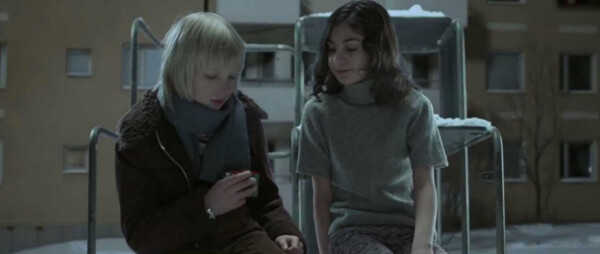
Image courtesy of EFTI, Sveriges Television and Filmpool Nord.
—
“Let the Right One In” Starring Kare Hedebrant, Lena Leandersson, Per Ragnar, Karen Bergquist. Directed by Tomas Alfredson. 115 minutes. Rated R.
Del’s take
You’re a 12-year-old boy and the bullies at school are eating your lunch. Wouldn’t it be nice if you could invoke the powers of your vampire girlfriend for a bloody session of attitude adjustment?
That’s the premise of “Let the Right One In,” a Swedish vampire flick that eerily and effectively reminds us that love comes along when it’s least expected, and from the unlikeliest of angles.
Oskar (Kare Hedebrant) is a pale, frail wisp of a boy who receives the unwanted attentions of a trio of bad boys at his school in the Stockholm suburb of Blackeberg. He fantasizes about revenge, sticking a knife into a tree and clipping newspaper articles about murders.
His home life isn’t much better. His parents are divorced. His alcoholic father lives in the country with a male friend while his mother works full-time and comes through the front door frazzled and worried. He spends much of his time at his apartment complex’s playground, dreaming of the escape he will never make happen.
He meets Eli (Lena Leandersson), the strange girl who has moved into the unit next door. She only comes out at night and seems impervious to the Swedish cold. Despite her pronouncement that she doesn’t want to be friends the two are drawn to each other, perhaps by their mutual strangeness.
Soon, bizarre murders haunt the streets of Blackeberg and Oskar, with Eli’s encouragement, stands up to his tormentors – the results are tragic. Still, “Let the Right One In” provides an option for hope.
But its most powerful virtue is the subtle elegance of its storytelling. “Let the Right One In” is flecked with moments of brutality, as any good 21st century vampire story must be. But it is also a serene journey through quiet, nighttime snowfalls, the unremitting gray of winter and the inevitable slide into dissolution that in this case is tempered by a weird redemption.
American audiences will not like the subtitles but never fear, in the tradition of “The Ring” and “The Grudge,” an Americanized version is due out this year.
“Let the Right One In” is not a movie for children or adults with timid constitutions. For everyone else it is a strange poem that will leave an uneasy impression that like water – or blood – love finds a way into the hardest of hearts.
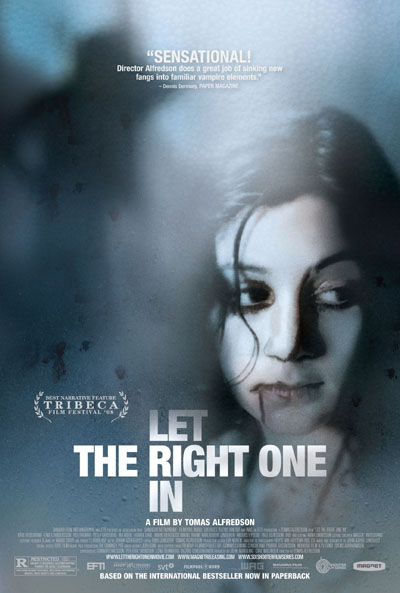
Mladen’s take
It’s clear by watching “Let the Right One In” that a vampire-friend would be useful if you’re the victim of bullies in middle school. Any middle school. Even a middle school in Sweden, where this very good, intermittently troubling film was made.
Before proceeding, let me stress that the penultimate scene in “Let the Right One In” offers one the finest pieces of cinematic slaughter ever created. Like much of the rest of the movie, its director, Tomas Alfredson, filmed the segment sparingly but punctuated it with bits of vivid dismemberment. The soundless incident was mesmerizing, not ghastly, though the victims were a couple of pre-teenagers and one adolescent.
“Let the Right One In” defies Hollywood-homogenized vampire film plots. It isn’t a sappy romance such as “Twilight” or a bloodletting similar to “30 Days of Night.”
It’s a movie about friendship, exploring the nature of honesty, loyalty, and trust. The protagonists are 12 years old but their struggles resonate with what we face as adults.
In one scene the dark-haired vampire cutie Eli accepts Oskar’s unvoiced gesture to enter his home, though he knows she must be invited verbally. Eli willingly placed her life in his hands by crossing the threshold and endured near-disintegration before he blurted “Come in” to end the horror.
Friendships have a darker side, too.
There’s the matter of making choices that close doors leading to other forms of happiness. There’s the urge to reciprocate. And, we inevitably become a little like the people considered friends.
Eli, shortly after the threshold incident, pounces on Oskar. She urges him too become more like her, something that, in fact, had been happening since the two met. Pay attention. At this moment and a couple of others, Eli’s young, creaseless face transforms, betraying the true age of her worn soul.
The movie ends with the impression that Eli had become more mankind-like and Oskar, more vampire-like, but both were human. Each of the two beings, it seems, had let the right one in.
Mladen Rudman is a former journalist and technical editor. Del Stone Jr. is a former journalist and author.
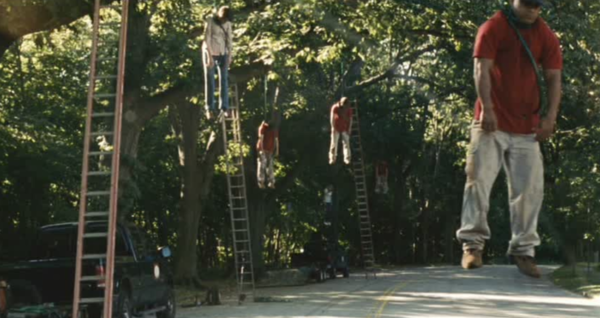
Image courtesy of 20th Century Fox.
—
“The Happening.” Starring Mark Wahlberg, Zooey Deschanel, John Lequizamo, and others. Directed by M. Night Shyamalan. 91 minutes. Rated R.
Del’s take
Terrorists have just attacked your city. An airborne agent is causing people to commit suicide en masse. You are standing in line to board what may the last train out of the danger zone. Do you:
(a) Get in line as quickly as possible and hope you actually find a seat on the train, or
(b) Make everyone wait as you and your wife have a long, soulful conversation about the strains in your marriage.
If this is an M. Night Shyamalan movie the answer is (b) of course, and that scene is emblematic of the problems with what could have been a nifty little horror movie, “The Happening.”
Two giant flaws will keep “The Happening” from joining my DVD collection – at least until it reaches the discount bin at Walmart: writing and direction. Shyamalan has been living off the good will generated by “The Sixth Sense” for many years, but he may have used up that charity. “The Happening” is an unrecoverable mess.
The movie begins with such promise. People in Central Park suddenly begin killing themselves in a plague of violence that spreads across the city. The first five minutes offer some really scary scene-setting – construction workers hurling themselves off a building, and cops shooting themselves in the head with their own guns.
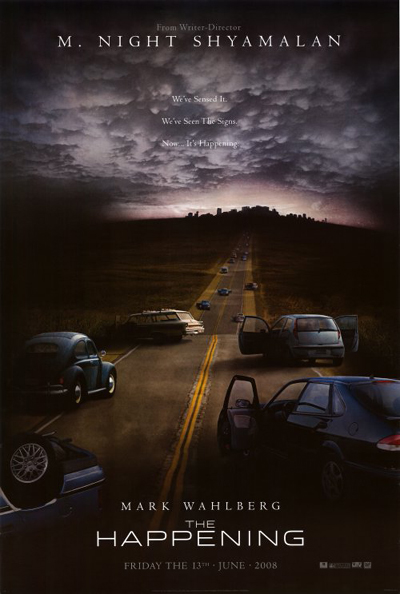
Science teacher Mark Wahlburg is summoned from his classroom after telling kids that some events are merely natural cycles that will never be explained (Galileo must be spinning in his grave) and learns a terrorist attack has threatened New York City. He calls his wife, Zooey Deschanel, and arranges to meet with a friend at the train station to evacuate. It is there that they have their marriage encounter as mobs of terrified civilians scramble to get aboard the train.
As they flee the city and the contagion spreads, they begin to realize the event is not a terrorist attack at all but a response from plants to the assault on the natural world by humankind.
The movie is filled with quietly gruesome scenes – a man lies down to allow a riding lawnmower to chop him to bits, or tree-trimmers hang themselves from the branches they were preparing to cut.
But it is the inane and distracting subplot between Wahlburg and Deschanel that ruins “The Happening.” Civilization is crumbling around them yet they pause – usually during moments of duress – to fret about their troubled relationship, which on the face of it doesn’t appear to be that troubled: Deschanel went out with a male coworker to enjoy an ice cream cone.
Not exactly “Who’s Afraid of Virginia Woolf.”
One more gripe: Throughout the movie the attack is referred to as “the event,” yet the title is “The Happening.” Why?
I think Shyamalan has succumbed to the bane of the untouchable creator – he who cannot be edited most desperately needs editing. It’s a shame because with a decent script and a more grounded director, “The Happening” could have been another sleeper like “The Sixth Sense.”
Del Stone Jr. is a former journalist and author.
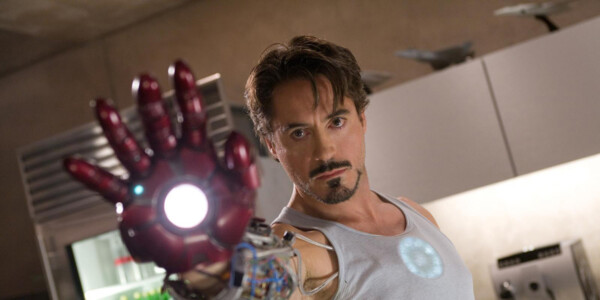
Image courtesy of Marvel Studios.
—
“Iron Man” Directed by Jon Favreau. Starring Robert Downey Jr., Jeff Bridges, Terence Howard and Gwyneth Paltrow. 126 minutes. Rated PG-13
Mladen’s take
Here’s a viewer’s guide to “Iron Man,” the blockbuster movie: DO NOT pay attention to details but DO stop thinking about the film the moment it ends.
“Iron Man” is light, entertaining fare suitable for matinee viewing.
Below is the partial list of flaws. Remember, the devil is in the details. Details are important to me if I’m going to swallow the director’s effort to make Iron Man a plausible do-gooder by setting him in the real world.
— Why would the planet’s premier weapons maker and billionaire playboy Tony Stark — Iron Man-to-be — go to Afghanistan to personally demonstrate a surface-to-surface artillery missile, an Army weapon, to a bunch of guys in the Air Force. Stark’s 19-billion-square-foot concrete mansion and adjoining property consume much of the western seaboard, so they must border the White Sands Missile Range. Wouldn’t it have been easier to test fire the Jericho missile there?
— If Stark, played by Robert Downey Jr., is the world’s premiere weapons designer and all-around genius, why does he use flares to try to defeat a radar-guided air-to-air missile fired at him while he’s in Iron Man mode? Shouldn’t he have dispensed chaff?
— Pepper Potts, Stark’s personal assistant, is played by breathtaking Gwyneth Paltrow. Why would it take womanizer Stark years to recognize her beauty and smarts and make a play for her. The romantic tension is the movie’s only awkward part.
— Why is an active-duty airman, a lieutenant colonel played by Terence Howard, attached to Stark as he roams the globe? The half-colonel also is one of Stark’s spokesmen.
— Why did Del automatically get a senior citizen discount from the elementary-school looking youngster in the ticket booth though he’s far from being a senior. I paid $2.50 more than Del to see “Iron Man,” a fact still stuck in my craw.
No question, “Iron Man” is over-hyped. It lacks the zest of the last truly iconic blockbuster released, “Jaws.” But, as long as you don’t pay full price for the ticket, the metal homo sapiens will keep you pleasantly distracted for some two hours.
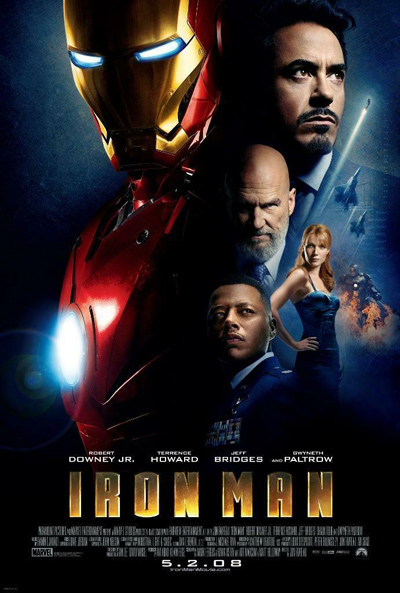
Del’s take
If it’s any consolation, Mladen, that senior citizen’s discount is stuck in my craw too. But $2.50 is half a gallon of gasoline and geezers like me need that gas to drive to all those cheap buffets around town.
And I wouldn’t say “Jaws” is the last iconic blockbuster. “E.T.,” “Aliens,” “Terminator 2” and “Titanic” all fit that category, to name a few.
But I agree. “Iron Man” doesn’t live up to the hype. It’s a decent enough movie … NOT another “Cloverfield” or “Dawn of the Dead,” which is the best movie ever made.
“Iron Man” is about a weapons developer who travels to Afghanistan and sees firsthand the horrors his products have inflicted on the innocent. He’s captured by terrorists, who force him to build a diabolical weapon for their nefarious use.
Instead, he builds a crude Iron Man exo-suit and uses it to escape his captors. Once back in the States he fabricates a superior version of the suit and vows to put the terrorists out of business permanently.
It’s all silly fun as Iron Man dodges jet fighters and decimates evil mujahideen while defying the physical laws of the universe. The movie requires a Herculean suspension of belief – science is non-existent as Iron Man flies from California to Afghanistan on a single tank of gas, plummets into the ground at hundreds of miles per hour only to arise unhurt, and crashes through the roof of his mansion to crush a sports car … try doing that in a Kia and see how far you get on your senior citizen’s discount.
Forget Robert Downey Jr. The real star of “Iron Man” is Jeff Bridges, who perfectly embodies the suave, lizard-tongued CEO of Stark Industries out to make a buck at the expense of friend, family and nation.
I think “Iron Man” is a good rental movie, not one to see in theaters – unless you’re getting in for $2.50 less than Mladen.
Mladen Rudman is a former journalist and technical editor. Del Stone Jr. is a journalist and author.
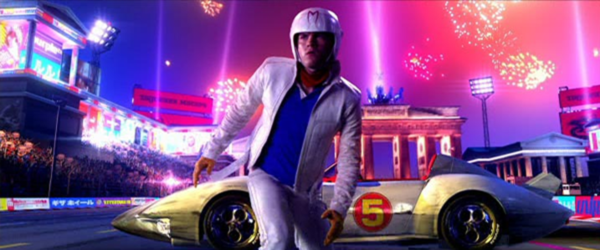
Image courtesy of Warner Brothers.
—
“Speed Racer” Directed by Andy and Larry Wachowski. Starring Emile Hirsch, Christina Ricci, John Goodman, Susan Sarandon. 135 minutes. Rated PG.
Del’s take
I hate animated films about as much as I hate films that synthesize animation with live action. And unless it’s “Batman” I am sick to death of comic book- and cartoon-inspired movies.
But instead of throwing up my lunch I simply threw up my hands and went with the hackneyed, cliched and utterly simple-minded “Speed Racer,” a movie in want of an audience dumb enough to enjoy it.
Despite its lurid color palette and fairy-tale plot, “Speed Racer” isn’t something kids will digest with their Happy Meals. Rather, it’s suffused with pell-mell destruction and adult themes of corruption, blackmail and death, most of which will go over the kiddies’ heads. But Mommy and Daddy can expect a grinding case of road rage over the money wasted on this interstate highway pileup of a flick.
The story goes like this: Young Speed (Emil Hirsch) grows up idolizing his older brother, Rex (Scott Porter), who is killed in a horrific wreck and accused of racing dirty, thereby sullying the family name. When Speed follows in Rex’s footsteps he is wooed by a large racing conglomerate headed by Mr. Royalton (Roger Allam), who threatens destruction upon the Racer family when Speed turns down his offer. Meanwhile the Togokahn racing organization, facing a hostile takeover by Royalton Industries, vows to win a final race, The Crucible, a cross-country destructo-derby where dirty tricks are the norm. They enlist Speed as a driver. If Togokahn wins the price of their stock will rise, bankrupting Royalton and exposing their race-fixing, and salvage the Racer family name.
Sounds like any number of little-guy-vs.-big guy potboilers, but what puts “Speed Racer” behind the pack is its lack of focus, thuddingly dense dialogue, dismissal of simple physics and jarring cinematography.
Where to begin? The brain swoons at the prospect. Is this a children’s movie or what? Should adults take it seriously? Are the overblown CGI effects a kind of commentary on the illusory nature of reality or merely the product of overzealous computer geeks?
Ultimately “Speed Racer” comes across as a rendering of “The Matrix” on Ecstasy, which is no coincidence: It was created by the Wachowski brothers, who guided the perpetually dazed and confused Keanu Reeves through his role as Neo in the otherworldly “Matrix” trilogy.
But unlike the original “Matrix” and the immensely satisfying “V for Vendetta,” the Wachowskis’ efforts are less successful here.
“Speed Racer” does not earn the checkered flag.

Mladen’s take
Ignore the bona fide movie critics, and Del, who pan the latest Wachowski brother’s effort. Rent “Speed Racer.” Make sure your subwoofer is working.
The plot is difficult to discern and the storytelling as blurry as the race scenes but what’s the big deal? No film is perfect.
Flashing unearthly psychedelic colors make the pseudo-animated movie a vivid delight. “Speed Racer” juxtaposes the dark plot with the cheerfulness of bright colors to say that shiny surfaces often disguise the evil beneath.
Pleasing-to-the-eye Christina Ricci, as Trixie, plays the role of an indomitable but discreet instigator with effective lightheartedness.
The actors portraying Spridle and ChimChim – or however the hell their names are spelled – add humor to the movie.
And, no kidding, John Goodman as Pops looks exactly like Pops in the “Speed Racer” cartoons.
Racers employ all sorts of dirty tricks against each other to keep, or get, lucrative corporate sponsorships. Races are fixed by bookies, an idea that the film’s makers could have ripped off from watching BCS college football computer models at work.
The vehicles depicted in the movie are beautiful. Powered by interlocking dihedral fusion c60 bucky balls or some such thing, the machines handle turns, loops, dips, jumps, sand, ice, rain, hot, cold, sideswipes, rearenders, frontenders, rocket-propelled grenades, hypoxia and the common cold with ease. It’s a wonder the driver’s weren’t fitted with G suits. Yes, the powerful Mach 5 and, later, Mach 6, have the gadgets featured in the cartoons and even some of the sound effects. Remember the “sproing” of the doohickeys that make the Mach 5 jump?
I would have preferred that “Speed Racer” the movie use as a plot something other than big business corruption and one boy’s push to keep the spirit of racing alive. What nonsense. All sports at all levels are about making money.
In fact, a pure action movie with no moral would have been ideal.
So, here’s the story for “Speed Racer” the sequel. A CG race against the Mammoth Car with the Car Acrobatic Team as its escort will blow off peoples’ socks. A subplot involving Racer X and the evil scientist who created the armored and tracker Car With A Brain must be worked in somehow. Finally, it would be helpful if in the sequel Speed reacts to Trixie’s sexiness with a thrill rather than dour sentimentality.
“Speed Racer” is worth watching. I’m thinking of adding it to my meager DVD collection, though not until the price drops to $5, or less.
Mladen Rudman is a former journalist and technical editor. Del Stone Jr. is a former journalist and author.

Image courtesy of Paramount Pictures.
—
“Cloverfield” Starring Lizzy Caplan, Jessica Lucas, T. J. Miller, Michael Stahl-David. Directed by Matt Reeves; created by J.J. Abrams. 85 minutes. Rated PG-13.
Mladen’s take
An amphibious monster, stories tall or a couple of blocks long, depending on the way you want to measure the beast, attacks Manhattan and it’s plausible.
That’s what makes “Cloverfield” work — the director takes the movie’s premise seriously.
Though “Cloverfield” sucks as a title, the movie becomes riveting after it finally cuts to explosions, toppled buildings, gunfire and missile and bomb attacks.
“Cloverfield” is realistic because it’s shot from the street-level point of view of a handful of people while the scaleless monster rampages through New York. The frenetic, jittery perspective you see on the big screen is captured by one of the survivors, who’s wielding a camcorder with the longest-lasting battery ever manufactured.
The CGI and the real blend flawlessly in this movie.
At any moment I expected cameraman Hud to focus on a still-functioning TV at an electronics story being looted as mayhem sweeps the island. President Bush comes on, the TV screen flickering.
“My fellow Americans, we are in a long war with monsters,” he would have said. “I don’t know when it will end, maybe never, but we will achieve victory. To protect you, I’m suspending all civil liberties and disbanding Congress. I can do that. It’s in the Constitution. Ask Dick Cheney. There’s no time for silliness like democracy while radical Islamic fundamentalist jihadist terrorists unleash such furry — ah, fury — on the good, holy people of America. God bless me, your savior.”
Like GM and Ford are finally starting to build cars that can compete with Japanese brands, Hollywood has finally released a movie that can compete with Japanese giant monsters such as Godzilla and Gamera.
See “Cloverfield” while it’s in theaters. Go to the bathroom and buy popcorn sometime during the movie’s first 20 minutes, which are spittle, and then prepare for a jolt.
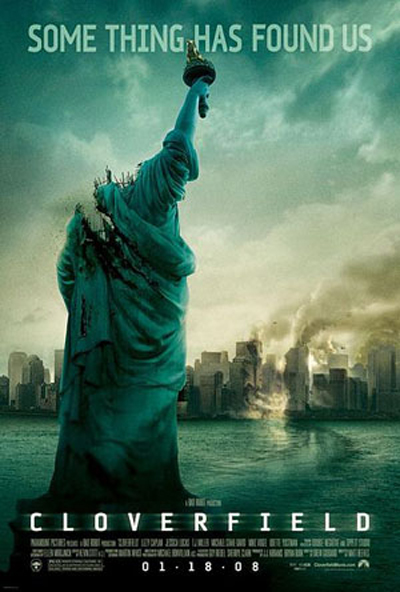
Del’s take
“Scaleless monster”? Mladen. I never thought of you as a dermaphobe.
Still, “Cloverfield” is a romp ’em stomp ’em bad ass monster of a movie, and anybody who disagrees needs to have his aura adjusted by a Marine drill sergeant.
OK, so the first 20 minutes are more “Quarterlife” than “Die Hard.” So what? That’s the part where we learn the viewpoint characters are as insipid and selfish as we. How else could we know that Rob is a metrosexual wussie who believes “commitment” is a dish best served cold?
But once the infrastructure starts rolling down the streets it’s a cinema verite grudge match featuring the icons of order vs. the forces beyond our control in a mighty metaphor for what’s happening in the world around us. If the U.S. could have dropped the “Cloverfield” monster on Fallujah, Barack Obama would be running a distant third.
Yes, we can niggle. How could that monster jump at a helicopter? What happened to Marlena behind the curtain? And in the movie’s final scene, did you really see something fall into the water? Oooh.
I just wish people would stop Blair Bitching about the jiggly camera motion – take a dramamine and call me in the morning. Ever read “The Sound and the Fury”? William Faulkner thought of the idea decades ago. If you can live with it on YouTube you can live with it in “Cloverfield.”
I think J.J. Abrams has kicked some serious Godzilla booty. This is not narrative storytelling. It’s slice-of-death moviemaking for a generation of voyeurs and narcissists who measure their worth in terms of the body count on their Facebook friends list.
In the movie’s penultimate scene we hear two very loud noises. Those were the sounds of a genre cracking under the weight of its own inertia and crashing into a new and limitless ocean of creative expression.
Let’s hope “Cloverfield” sinks a few ships.
Mladen Rudman is a former journalist and technical editor. Del Stone Jr. is a former journalist and author.